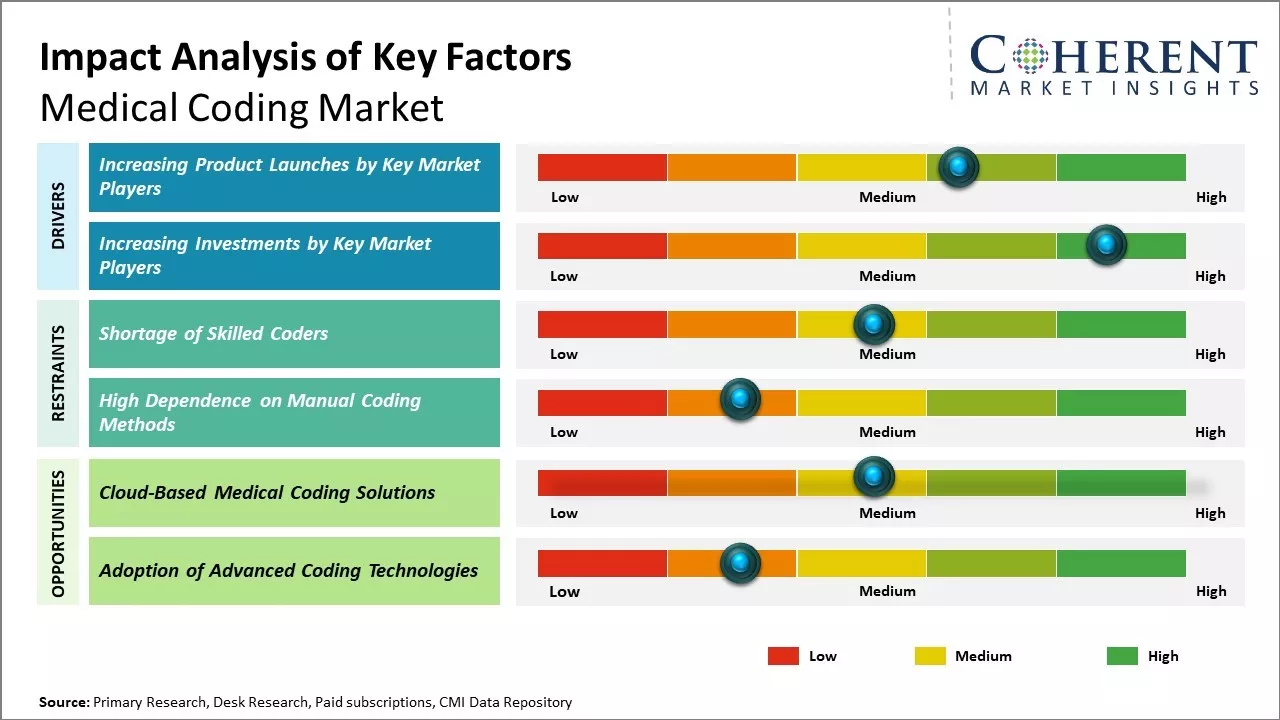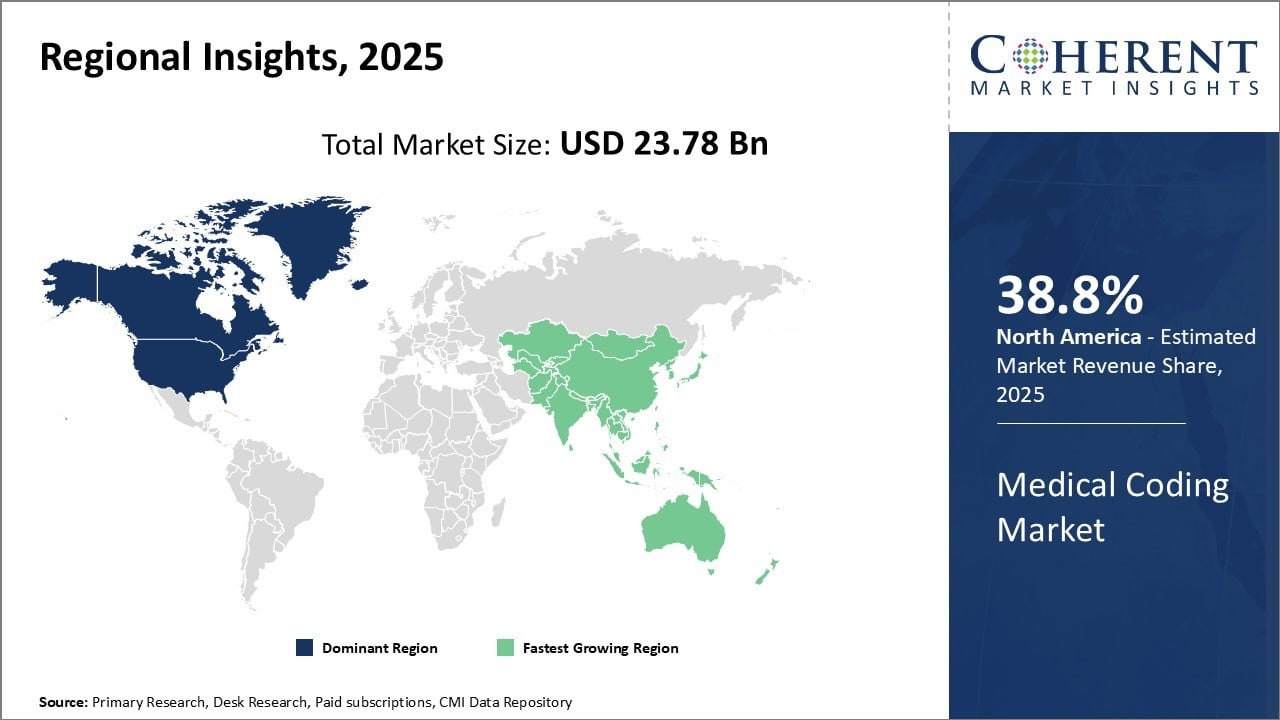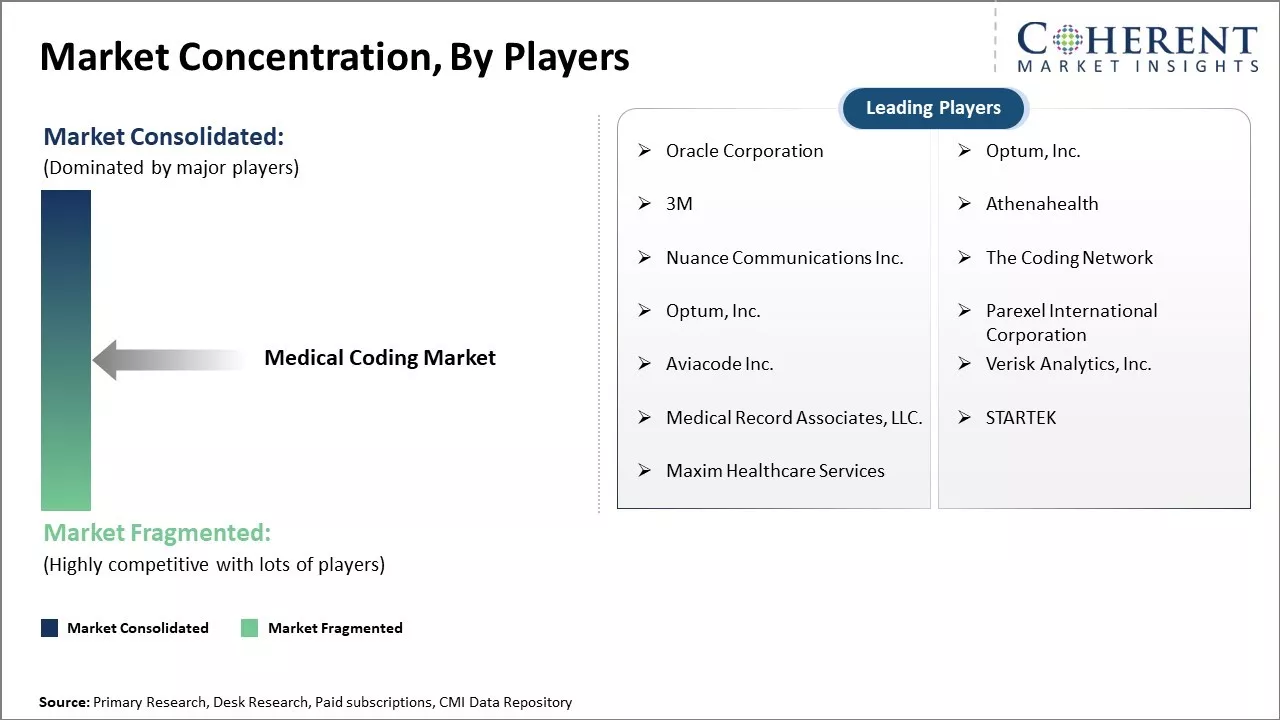
Medical Coding Market is estimated to be valued at USD 23.78 Bn in 2025 and is expected to reach USD 45.79 Bn in 2032, exhibiting a compound annual growth rate (CAGR) of 9.8% from 2025 to 2032.

To learn more about this report, Download Free Sample
The medical coding market is expected to witness significant growth over the forecast period. This can be attributed to rising incidences of diseases owing to increasing geriatric population globally and the subsequent need for accurate medical documentation and billing. Furthermore, various initiatives undertaken by governments and private organizations to reduce healthcare costs are also expected to boost the market growth.
For instance, in January 2025, KODE Health, announced that it has raised $27 Mn in Series B funding led by Noro-Moseley Partners with participation from Mercury, FCA Venture Partners, Epsilon Innovation Fund and 111 West Capital.
|
Event |
Description and Impact |
|
Surge in Telehealth Services |
|
|
Remote Coding and Outsourcing |
|
Uncover macros and micros vetted on 75+ parameters: Get instant access to report
The classification system segment includes international classification of diseases (ICD) and healthcare common procedure code system (HCPCS). The international classification of diseases (ICD) sub-segment is estimated to hold 63.9% of the market share in 2025 owing to its widespread global adoption for clinical documentation and medical billing purposes across both inpatient as well as outpatient healthcare settings.
ICD coding standards set by the World Health Organization are regularly updated to align with advancements in medical science and changes in healthcare policies across nations. The ongoing transition towards value-based reimbursement models in major markets like the U.S. and parts of Europe has intensified the focus on using ICD codes for quality reporting, risk adjustment, and care coordination.
This is driving hospitals and physician practices to bolster their on-site coding staff as well as outsource more complex coding workloads. Furthermore, the emergence of electronic health records has simplified the process of capturing ICD codes at the point of care, thereby supporting their broader usage.
The component segment includes in-house and outsourced. The in-house sub-segment is estimated to hold 58.7% of the market share in 2025 owing to the scale of medical coding workload and global shortage of trained clinical coders. Healthcare organizations, especially hospitals, find it difficult to hire and retain coders due to intense competition and complex nature of job. This has prompted many providers to partially or fully outsource their coding functions to specialty firms offering scalable offshore and onshore solutions.
Outsourced coding allows hospitals to focus on their core clinical operations while benefiting from outsourcers' economies of scale, advanced technologies, qualified workforce, and flexible staffing models. It has emerged as a cost-effective strategy for facilities located in rural or underserved areas with limited access to local coding talent. Moreover, outsourcing provides an avenue for on-going training and certification of coders.
The end user segment includes hospitals, diagnostic centers, and others. The hospitals sub-segment is estimated to hold 36.1% of the market share in 2025 driven by the Healthcare Common Procedure Coding System (HCPCS). HCPCS codes are essential for professional billing and the reimbursement of diagnostic and minor procedures performed in physician clinics and diagnostic centers. They enable the efficient processing of insurance claims and compliance with changing regulations.
The rising volume of outpatient visits and shift towards specialized ambulatory care are compelling such facilities to focus more on documentation, billing, and revenue cycle management. This is positively impacting investments in medical coding infrastructure and outsourced support. Furthermore, HCPCS coding improves consistency in coding practices and helps generate actionable analytics for the management of ambulatory care operations.

To learn more about this report, Download Free Sample
North America remains the dominant region in the global medical coding market and is estimated to hold 38.8% of the market share in 2025. Stringent regulations surrounding healthcare reimbursement and documentation in the U.S. drive substantial demand for coding services. Most leading medical coding outsourcing firms have established their headquarters and primary operations catering to the U.S. in this region.
The presence of sophisticated healthcare IT infrastructure and widespread adoption of electronic health records in the U.S. and Canada are other factors contributing to North America's prominence. Automated coding tools integrating emerging technologies such as artificial intelligence are finding higher traction in this market. However, human expertise continues to play a critical role, given the complexity associated with Medicaid reimbursement guidelines. This ensures ongoing employment opportunities for medical coders.
Asia Pacific is witnessing the fastest growth and emerging as the new hotspot for the medical coding market. Countries like India, China, the Philippines, and Malaysia offer lucrative cost advantages that are attracting leading global firms to establish offshore coding centers. These nations are experiencing high economic expansion and see healthcare spending rising rapidly in line with GDP growth. The availability of educated English-speaking workforces has powered Asia Pacific's ascension.
However, Asia Pacific also faces certain challenges in this market. Healthcare systems and reimbursement mechanisms across nations vary greatly compared to developed markets. Coding standards and guidelines still lack uniformity. Yet ongoing reforms, rising medical tourism, and the region's huge patient pools signal promising future potential. Outsourcing to Asia Pacific allows firms to achieve significant cost reductions while tapping growing international demand. If standards can be further harmonized, Asia Pacific is set to increasingly dominate the global supply of medical coding services.
Furthermore, the region's coding procedures are becoming more uniform due to the push for interoperable health IT systems and the implementation of worldwide coding standards like ICD-11. Germany, the UK, and France are important European markets that profit from robust universal healthcare programs and continuous investments in healthcare IT infrastructure. It is anticipated that the use of cloud-based solutions and the outsourcing trend will continue, guaranteeing steady market growth in the upcoming years.
Due to its sophisticated healthcare system, extensive use of electronic health records (EHRs), and strict regulations requiring correct coding for Medicare, Medicaid, and private insurance reimbursement, the United States dominates the global medical coding business.
India has emerged as a major hub for outsourced medical coding services, leveraging its large, skilled workforce and cost-effective solutions for global healthcare providers. Government initiatives to improve healthcare documentation standards, coupled with the rise in medical tourism and the integration of automation into training programs, are strengthening India’s position as a global leader in medical coding outsourcing.
China's medical coding market is expanding as the country modernizes its healthcare system and implements international coding standards to improve data accuracy and healthcare management. The growth is propelled by government reforms aimed at enhancing healthcare quality, increasing health insurance penetration, and the adoption of digital health technologies.
| Report Coverage | Details | ||
|---|---|---|---|
| Base Year: | 2024 | Market Size in 2025: | USD 23.78 Bn |
| Historical Data for: | 2020 To 2024 | Forecast Period: | 2025 To 2032 |
| Forecast Period 2025 to 2032 CAGR: |
9.8% |
2032 Value Projection: | USD 45.79 Bn |
| Geographies covered: |
|
||
| Segments covered: |
|
||
| Companies covered: |
Oracle Corporation, Optum, Inc., 3M, Athenahealth, Nuance Communications Inc., The Coding Network, Optum, Inc., Parexel International Corporation, Aviacode Inc., Verisk Analytics, Inc., Medical Record Associates, LLC., STARTEK, and Maxim Healthcare Services |
||
| Growth Drivers: |
|
||
| Restraints & Challenges: |
|
||
Uncover macros and micros vetted on 75+ parameters: Get instant access to report

To learn more about this report, Download Free Sample
Increasing adoption of organic growth strategies such as product launches by key market players is expected to drive the market growth over the forecast period. For instance, in June 2021, Semantic Health Inc., a healthcare technology company, announced the launch of its premier coding & auditing platform, the Semantic Health Information Platform.
Semantic Health Inc.'s platform empowers medical coders and auditors to conduct concurrent review of clinical documentation, reduce revenue cycle inefficiencies, and enable actionable use of unstructured data. The platform was developed in close collaboration with medical coding and auditing professionals across various health systems in North America.
Increasing adoption of inorganic growth strategies such as investments and fundings is expected to drive the market growth over the forecast period. For instance, in March 2024, CodaMetrix, the leading artificial intelligence (AI) solution for transforming healthcare and revenue cycle management, announced a funding of USD 40 million to advance medical coding quality and clinically enrich claims data through artificial intelligence (AI).
Asia Pacific has presence of large population pool, and the region is witnessing expansion of disposable income among customers, due to which food packaging industry is one of the major markets in the region. Moreover, technological developments across countries in the region are enabling premium food manufacturers to deliver unique food choices in long-lastingly and sustainable manner.
Due to digital transformation of enterprises, the emergence of automation powered by digital technologies such as AI and robotics is increasing around the world. This is likely to help companies reduce cost of manufacturing. The use of robotic filling equipment allows packagers to create more than they can with manual product filling.
This technology can enable dependable, repeatable, and consistent fill with every cycle, whether the fill is based on a volume, level, weight, or another measurement. Thus, growing digital transformation of enterprises to fuel growth of the global Medical Coding market during the forecast period.
Cloud-based medical coding solutions have a huge potential in the global medical coding market. With the advancements in cloud computing and its benefits like scalability, flexibility, and cost-effectiveness, more and more healthcare organizations are adopting cloud-based medical coding solutions. Cloud-based solutions allow remote access to coding software from anywhere using an internet connection.
This enables medical coders to work remotely and efficiently handle the large coding workload of healthcare facilities. It also empowers healthcare organizations to scale up or down their coding needs based on volume fluctuations easily. With the COVID-19 pandemic emphasizing the importance of remote and flexible working models, the demand for cloud-based medical coding is set to rise substantially in the coming years.
*Definition: Medical coding is the process of applying universal alphanumeric codes to healthcare services, i.e., medical diagnosis, medical services, medical procedures, and medical equipment provided. Currently, medical coding is being increasingly used to create a proper of patient care, identify healthcare areas that require focus, streamline billing process, and accelerate payments to physicians. Medical coders are individuals responsible for translating physicians reports into useful medical codes, which may include a patient’s condition, doctor’s diagnosis prescription, and procedures performed on the patient, ensuring all vital information is coded appropriately to ensure consistency and accuracy. Medical coding helps to improve efficiency, reduce degree of errors, and simplify the tedious work of administrative staff.
Share
Share
About Author
Komal Dighe is a Management Consultant with over 8 years of experience in market research and consulting. She excels in managing and delivering high-quality insights and solutions in Health-tech Consulting reports. Her expertise encompasses conducting both primary and secondary research, effectively addressing client requirements, and excelling in market estimation and forecast. Her comprehensive approach ensures that clients receive thorough and accurate analyses, enabling them to make informed decisions and capitalize on market opportunities.
Missing comfort of reading report in your local language? Find your preferred language :
Transform your Strategy with Exclusive Trending Reports :
Frequently Asked Questions
Joining thousands of companies around the world committed to making the Excellent Business Solutions.
View All Our Clients